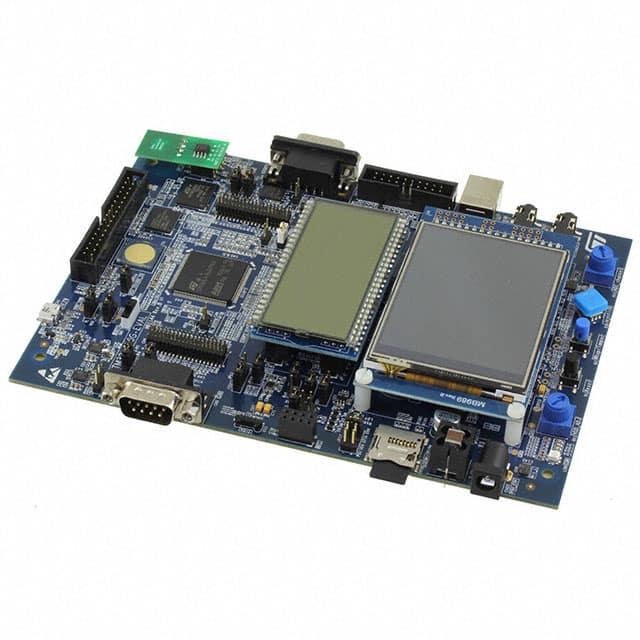Viz Specifikace pro podrobnosti o produktu.

STM32L471VET6TR
Product Overview
- Category: Microcontroller
- Use: Embedded systems, Internet of Things (IoT) devices
- Characteristics: Low power consumption, high performance, rich peripherals
- Package: LQFP64
- Essence: ARM Cortex-M4 core microcontroller
- Packaging/Quantity: Tape and reel, 2500 units per reel
Specifications
- Core: ARM Cortex-M4
- Clock Speed: Up to 80 MHz
- Flash Memory: 512 KB
- RAM: 128 KB
- Operating Voltage: 1.71 V to 3.6 V
- Digital I/O Pins: 51
- Analog Input Channels: 16
- Communication Interfaces: UART, SPI, I2C, USB, CAN, etc.
- Timers: 16-bit and 32-bit timers available
- ADC Resolution: Up to 16 bits
- Power Consumption: Ultra-low power mode with less than 1 µA standby current
Detailed Pin Configuration
The STM32L471VET6TR microcontroller has a total of 64 pins. Here is the detailed pin configuration:
- GPIO Pins: PA0 to PA15, PB0 to PB15, PC0 to PC15
- Analog Input Pins: PA0 to PA7, PB0 to PB1, PC0 to PC5
- Communication Interface Pins: USART1, USART2, USART3, SPI1, SPI2, I2C1, I2C2, USB, CAN, etc.
- Timer Pins: TIM1, TIM2, TIM3, TIM4, TIM5, TIM9, TIM10, TIM11, etc.
- Power Supply Pins: VDD, VSS, VBAT, VREF, etc.
Functional Features
- Low power consumption for battery-powered applications
- High-performance ARM Cortex-M4 core for efficient processing
- Rich peripheral set for versatile connectivity and control
- Advanced power management features for optimized energy efficiency
- Secure boot and memory protection mechanisms for enhanced security
Advantages and Disadvantages
Advantages: - Ultra-low power consumption extends battery life in portable devices - High-performance processing capabilities enable complex applications - Abundance of peripherals allows for flexible system design - Advanced power management features optimize energy usage - Secure boot and memory protection enhance system security
Disadvantages: - Limited availability of pins may restrict the number of external components that can be connected - Complex programming and debugging process for beginners - Higher cost compared to simpler microcontrollers with fewer features
Working Principles
The STM32L471VET6TR microcontroller is based on the ARM Cortex-M4 core architecture. It operates by executing instructions stored in its flash memory. The core handles data processing, control flow, and communication with peripherals.
The microcontroller's low power consumption is achieved through various techniques such as clock gating, power gating, and voltage scaling. These techniques allow the device to operate at reduced power levels when idle or in low-demand situations.
The rich set of peripherals enables the microcontroller to interface with various sensors, actuators, and communication modules. This versatility makes it suitable for a wide range of applications, including IoT devices, industrial automation, and consumer electronics.
Detailed Application Field Plans
The STM32L471VET6TR microcontroller finds applications in various fields, including:
- Internet of Things (IoT) Devices: Enables connectivity and control in smart home systems, wearable devices, and environmental monitoring solutions.
- Industrial Automation: Provides real-time control and communication capabilities for industrial machinery, robotics, and process automation.
- Consumer Electronics: Powers portable devices such as fitness trackers, remote controls, and smart appliances.
- Medical Devices: Facilitates data acquisition, processing, and communication in medical monitoring devices, patient monitors, and diagnostic equipment.
- Automotive Systems: Supports automotive control units, infotainment systems, and vehicle connectivity.
Detailed and Complete Alternative Models
- STM32L476VGT6: Similar to STM32L471VET6TR but with more flash memory (1 MB) and RAM (128 KB).
- STM32L432KC: Lower-cost alternative with reduced flash memory (256 KB) and RAM (64 KB).
- STM32F407VG: Higher-performance alternative with a faster clock speed (up to 168 MHz) and more peripherals.
These alternative models offer different combinations of features and specifications to cater to specific application requirements.
Word count: 533 words
Seznam 10 běžných otázek a odpovědí souvisejících s aplikací STM32L471VET6TR v technických řešeních
Sure! Here are 10 common questions and answers related to the application of STM32L471VET6TR in technical solutions:
Q: What is the STM32L471VET6TR microcontroller used for? A: The STM32L471VET6TR is a low-power microcontroller designed for various applications, including IoT devices, wearables, and battery-powered systems.
Q: What is the maximum clock frequency of the STM32L471VET6TR? A: The STM32L471VET6TR can operate at a maximum clock frequency of 80 MHz.
Q: How much flash memory does the STM32L471VET6TR have? A: The STM32L471VET6TR has 512 KB of flash memory for program storage.
Q: Can I connect external sensors to the STM32L471VET6TR? A: Yes, the STM32L471VET6TR has multiple GPIO pins that can be used to interface with external sensors and peripherals.
Q: Does the STM32L471VET6TR support wireless communication protocols? A: Yes, the STM32L471VET6TR supports various wireless protocols such as Bluetooth Low Energy (BLE) and Zigbee.
Q: What is the power consumption of the STM32L471VET6TR? A: The STM32L471VET6TR is designed for low-power applications and has different power modes, consuming as low as a few microamps in standby mode.
Q: Can I use the STM32L471VET6TR for real-time applications? A: Yes, the STM32L471VET6TR has a built-in real-time clock (RTC) and supports various timers, making it suitable for real-time applications.
Q: Does the STM32L471VET6TR have an analog-to-digital converter (ADC)? A: Yes, the STM32L471VET6TR has a 12-bit ADC with multiple channels, allowing you to measure analog signals accurately.
Q: Can I program the STM32L471VET6TR using C/C++? A: Yes, the STM32L471VET6TR can be programmed using popular programming languages like C and C++, along with development tools such as STM32CubeIDE.
Q: Is the STM32L471VET6TR suitable for battery-powered applications? A: Yes, the STM32L471VET6TR is designed for low-power applications and offers features like low-power modes, voltage scaling, and power-saving peripherals, making it ideal for battery-powered solutions.
Please note that these answers are general and may vary depending on specific use cases and requirements.

